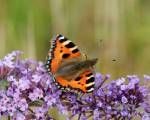
Small Tortoiseshell on butterfly bush Photo: Christine Cassidy
Sometimes, we disassociate ourselves when ecology and biodiversity are mentioned. We somehow feel these terms are more appropriate for farmlands and acreage, but this couldn’t be further from the truth. A strip of wasteland with nothing more than ‘weeds’ can provide food for a vast number of insects, and birds and mammals thrive as a result.European Honey Bee ( Apis mellifera ) - Photo Credit: Nicolas Macaire
In an ideal world we should plant only native species but the fact is some cultivated plants available for purchase are those that are on the international endangered list, or, are already extinct in the wild. Our gardens have become a refuge for plants that might otherwise be extinct and Chocolate cosmos is a very good example of this. Last seen in it’s native habitat in 1902 it is now a firm favourite amongst ‘Bourneville’ lovers around the world!Chocolate Cosmos Cosmos atrosanguineua
So what plants do we need?To encourage those pollinators mentioned here a good source of nectar-rich plants is required. Bumblebees adore Foxgloves and Poached Egg plants, while, Butterfliesprefer Sedums, Echinacea, Verbena bonariensis and of course Butterfly bush.
Spear Thistle (Scotch Thistle) - Cirsium vulgare Photo: Lesley Crawshaw
Bumblebees & Goldfinches benefit from this invaluable wildflowerCommon Blue Butterfly on Common vetch Photo: Galway Botanic Gardens
If you want to encourage birds to feed and nest in your garden have a read of this. If you’re gardening from scratch, ensure you plant a wildlife corridor which in turn will provide sheltered areas for birds to nest and feed. Ideally trees that produce berries or seeds should be planted as they’ll provide a natural source of food for birds in autumn and winter (as well as shelter and shade all year round). If you haven’t yet read the best trees for your garden it’s here.Goldfinch Carduelis carduelis on Teaser Photo credit: Jean-Jacques Carlier
While the best shrubs to provide berries for birds are pyracanthas (not the yellow-berried varieties though), berberis, elder, and female varieties of holly are good too. Amelanchier lamarckii (snowy mespilus) has delicious edible fruits adored by both humans and birds in late Summer early Autumn. The flowers of ivy will produce berries which are a good food supply in the winter for birds. You may also notice birds such as dunnocks, chaffinches and blackbirds nesting amongst the intertwining stems.Greenfinch Photo: Christine Cassidy
Don’t forget to read Do’s and Don’ts to complete your wildlife gardening. Happy Gardening




